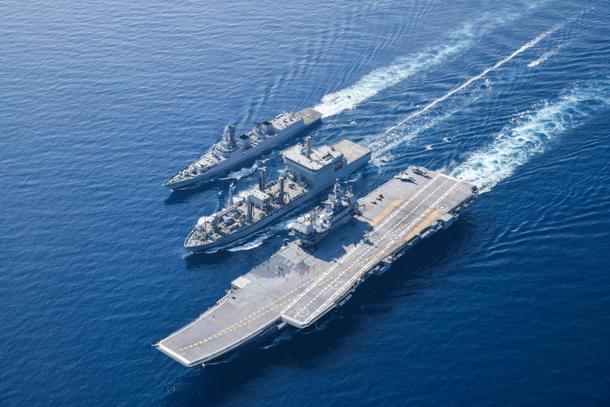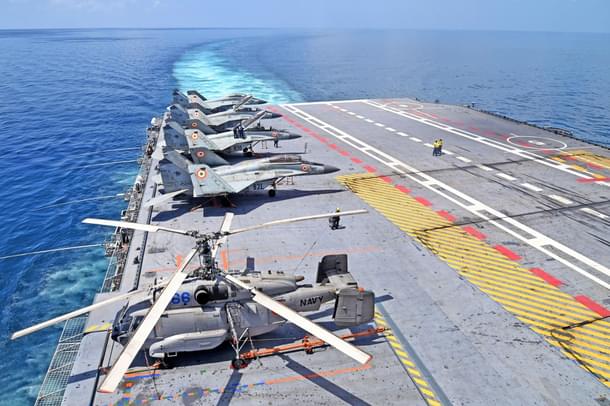Defence
Vikrant, 1961 To Vikrant, 2022: Journey To Self-Reliance, Eminence And Resurgence
V Bhagya Subhashini
May 24, 2023, 11:35 AM | Updated 12:34 PM IST
Save & read from anywhere!
Bookmark stories for easy access on any device or the Swarajya app.


India celebrated a historical milestone as it commissioned its first-ever indigenous aircraft carrier (IAC)- Vikrant on 2 September 2022.
The carrier is named in honour of her historic predecessor, India's first aircraft carrier, which played an important part in the war of 1971.
With the IAC Vikrant, India has joined an elite group of countries with the specialised capacity to design and construct an aircraft carrier domestically, including the US, UK, France, Russia and China.
Significance Of 'Aircraft Carriers — Conquerors Of The Air And Sea'
Former US defence secretary William Cohen was fond of saying that the United States has "less of a voice" without "flattops" (aircraft carriers).
Aircraft carriers are the central instruments for the overall command and control of maritime operations. Aircraft carriers are extremely strong and have powerful weapons. Their military capabilities, which include carrier-borne aircraft, have completely changed the marine domain.
Power Projection: Aircraft carriers are potent symbols of military power and enable the projection of air power over large distances.
Strategic Presence: The presence of aircraft carriers in the Indo-Pacific region increases the overall strategic presence.
Maritime Domain Awareness: An aircraft carrier offers a wide range of strategic benefits. It offers incredibly flexible operational options. Surveillance, air defence, airborne early warning, protection of Sea Lines of Communication (SLOC), and anti-submarine warfare are some of its principal functions.
Rapid Response: Carriers can quickly move to different locations, providing a flexible and rapid response capability. They can be deployed to crisis zones or areas of interest swiftly, enabling timely interventions or humanitarian assistance in times of need.
Air Superiority: Carriers provide a platform for air superiority operations, allowing for the deployment of fighter jets and other aircraft to establish control of the skies. This capability is vital in deterring potential adversaries, protecting other assets, and providing a protective umbrella for ground forces.
For India, the carrier battle group, with its inherent combat elements and firepower, becomes a key capability to establish effective air dominance and efficient sea control.
Since the sixties, the Indian Navy has had the unique distinction of operating all variants of aircraft launch and recovery systems.
Here is a walkthrough of India’s prestigious aircraft carriers till now:
INS Vikrant — India’s First Aircraft Carrier
The 19,500-tonne carrier, INS Vikrant was the first-ever carrier for an Asian country and remained so for a long time. Soon after its commissioning, the INS Vikrant saw action during the Goa Liberation Operation in 1961.
It played a crucial role in the 1971 war with its aircraft decimating the enemy. The INS Vikrant helped in preventing the reinforcement of Pakistani forces from the sea, leading to the birth of Bangladesh.
The INS Vikrant emerged in a new avatar as a vertical/short take off and land (V/STOL) carrier in 1984, with the brand new, state-of-the-art aircraft Sea Harrier. Its new capability inspired the induction of INS Vikramaditya and the plans for its reincarnation.


After serving for 36 years, it was decommissioned from active service on 31 January 1997.
The 'Viraat Era'
INS Viraat was commissioned into Indian Navy on 12 May 1987. After acing a set of tests and trials, on 23 July 1987, it sailed from Plymouth to India, reaching the Indian waters on 21 August 1987. It was 227 metres long and 49 metres wide and had a full load displacement of 28,700 tonnes.
INS Viraat’s first major operation was ‘Operation Jupiter’ in July 1989 as part of peacekeeping operations in Sri Lanka, following the breakdown of the Indo-Sri Lankan Accord of 1986.
By establishing a blockade against Pakistan during the 1999 Kargil War, the INS Viraat also played a crucial part in Operation Vijay. It also played a pivotal role in Operation Parakram, which was carried out in the wake of the 2001 terrorist attack on the Indian Parliament.
The ship's last operational deployment was in February 2016 when it took part in the International Fleet Review (IFR-2016) at Visakhapatnam.

It was decommissioned from service on 6 March 2017.
INS Vikramaditya — The Floating City
Russia’s refurbished Admiral Gorshkov was commissioned into the Indian Navy as INS Vikramaditya at Severodvinsk, Russia on 16 November 2013.
INS Vikramaditya, the floating airfield has an overall length of about 284 metres and a maximum beam of about 60 metres, stretching as much as three football fields put together.
Standing about 20 storeys tall from the keel to the highest point, the sheer sight of this 44,500-tonne mega structure of steel is awe-inspiring. The ship has a total of 22 decks.
With over 1,600 personnel on board, INS Vikramaditya is literally a ‘Floating City’. With a capacity of over 8,000 tonnes of low sulphur high-speed diesel (LSHSD), it is capable of operations up to a range of over 7,000 nautical miles or 13,000 km.
The ship has the ability to carry over 30 aircraft, comprising an assortment of MiG 29K/Sea Harrier, Kamov 31, Kamov 28, Sea King, ALH-Dhruv and Chetak helicopters. The MiG 29K swing role fighter is the main offensive platform and provides a quantum jump for the Indian Navy’s maritime strike capability.
These fourth-generation air superiority fighters provide a significant fillip for the Indian Navy with a range of over 700 nm and an array of weapons including anti-ship missiles, beyond visual range air-to-air missiles, guided bombs and rockets.



The ship is equipped with state-of-the-art launch and recovery systems along with aids to enable the smooth and efficient operation of ship-borne aircraft.
INS Vikramaditya was upgraded by stripping weapons from the foredeck to make way for a 'short take-off but arrested recovery' (STOBAR) flight deck, and modification of other associated structures to convert from a 'hybrid' anti-submarine warfare cruiser (under Soviet nomenclature) to a 'pure' aircraft carrier with a ski jump.
INS Vikrant: The Self-Reliant Rebirth
INS Vikrant is designed by Indian Navy's inhouse Warship Design Bureau (WDB) and built by Cochin Shipyard Limited (CSL). Vikrant has been built with state-of-the-art automation features and is the largest ship ever built in the maritime history of India.
Prime Minister Narendra Modi commissioned INS Vikrant and noted that it is a symbol of indigenous potential, indigenous resources and indigenous skills.
The 262-metre-long carrier has a full displacement of close to 45,000 tonnes which is much more advanced than its predecessor. The ship is powered by four gas turbines totalling 88 MW power and has a maximum speed of 28 knots.
Built at an overall cost of close to Rs 20,000 crore, the project has progressed in three phases of contract between MoD and CSL. It has an overall indigenous content of 76 per cent.
Vikrant has been built with a high degree of automation for machinery operation, ship navigation and survivability, and has been designed to accommodate an assortment of fixed-wing and rotary aircraft.
The ship would be capable of operating an air wing consisting of 30 aircraft comprising of MIG-29K fighter jets, Kamov-28, MH-60R multi-role helicopters, in addition to indigenously manufactured advanced light helicopters (ALH) and light combat aircraft (LCA) (Navy).
Using a novel aircraft operation mode known as STOBAR, the IAC is equipped with a ski-jump for launching aircraft and a set of 'arrester wires' for their recovery onboard.




“Vikrant is not just a warship. This is a testament to the hard work, talent, influence and commitment of India in the 21st century. If the goals are distant, the journeys are long, and the ocean and the challenges are endless — then India's answer is Vikrant. Vikrant is a unique reflection of India becoming self-reliant,” noted Prime Minister Modi, reinforcing the significance of the carrier.
The indigenous carrier contributes significantly to 'Make in India' and 'Atmanirbhar Bharat,' and the 'plough back effects' of such enterprises on the economy are enormous.
The aircraft carriers — INS Vikrant and INS Vikramaditya, along with the naval forces of the QUAD nations (India, Australia, the US, and Japan), will act as a deterrence to the Chinese People Liberation Army Navy from undertaking any aggressive manoeuvres in the Indo-Pacific.
Way Forward
IAC-2?
The IAC-2 is envisioned as a 65,000-tonne carrier with integrated full electric propulsion (IFEP) and a top speed of 30 knots. The catapult assisted take-off but arrested recovery (CATOBAR) idea of flying operations with enhanced landing and recovery equipment would be used.
The IAC-2 project would create extensive job opportunities/skill development, infrastructure augmentation, encourage indigenous shipbuilding and business opportunities to micro, small and medium enterprises, according to Admiral Karambir Singh (Retd).
However, Indian Navy is planning to go for a repeat order of a modified INS Vikrant-sized carrier for the indigenous aircraft carrier 2 (IAC-2) instead of the larger 65,000-tonne carrier, The Hindu reported.
The Indian Navy Chief Admiral R Hari Kumar on the sidelines of Aero India 2023 said, “While placing a repeat order for the INS Vikrant-sized carrier, the Navy will continue to study the need for a larger and more capable carrier”.
“The Indian Navy requires three aircraft carriers because when the ship undergoes maintenance, it takes time given its very big size, and there may also be delays ” the Admiral added.
To conclude, today's globe is a maritime world, and India's future is inextricably linked to the Indian Ocean. India's key position in the Indian Ocean Region, astride the world's most critical sea-lanes, provides us with significant strategic benefits.
In the upcoming 10 years, there will also be an increase in the geo-strategic challenges facing the Indian Ocean.
Air power at sea will enhance our maritime troops' reach, sustenance, and mobility, allowing us to effectively dominate maritime environment.
V Bhagya Subhashini is a staff writer at Swarajya. She tracks infrastructure developments.





